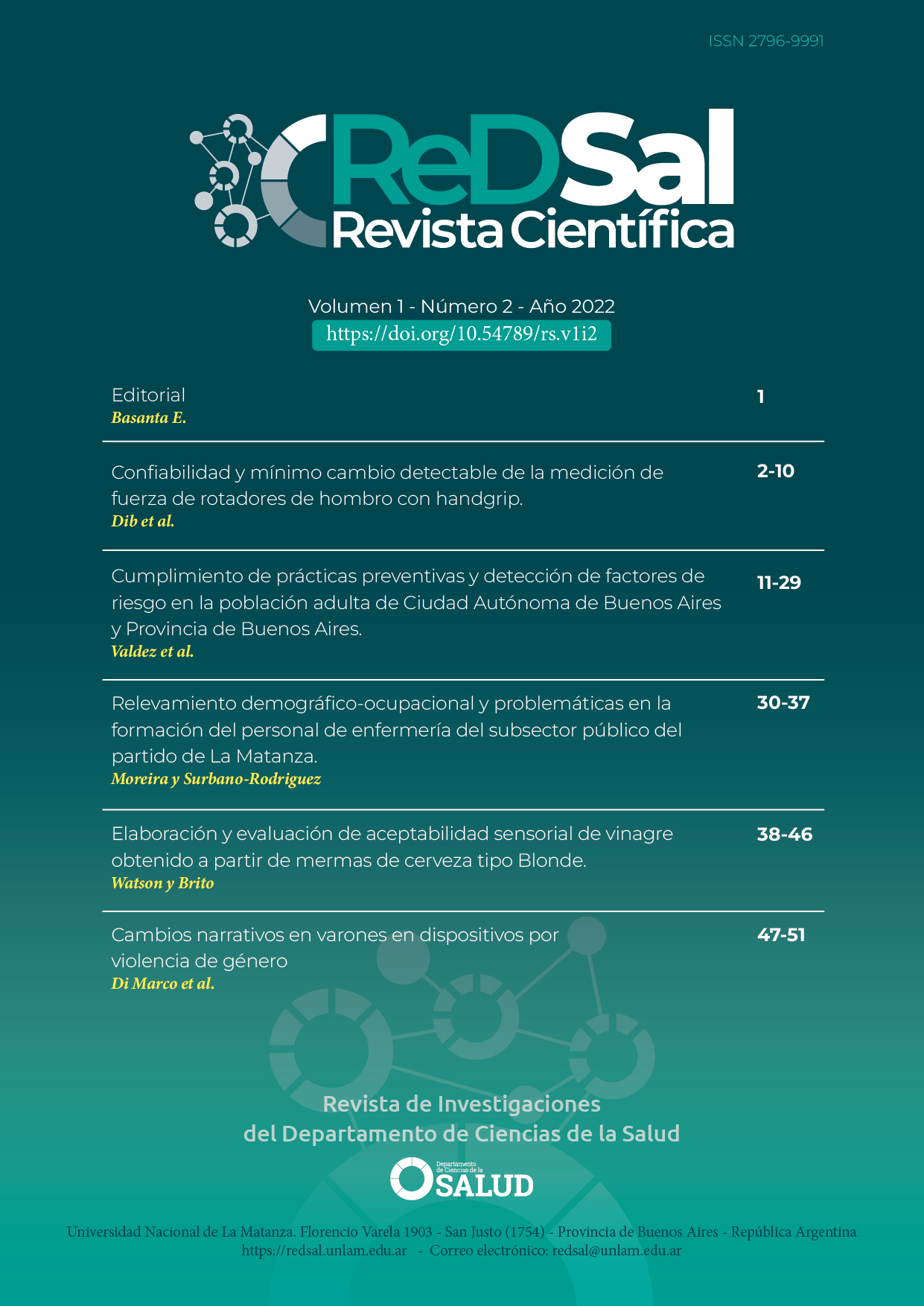Elaboration and sensory acceptability of vinegar obtained from the waste of Blonde type beer
DOI:
https://doi.org/10.54789/rs.v1i2.13Keywords:
acetic acid, beer, sensory analysis, sustainable development, consumer behavior, food productionAbstract
Introduction: It is necessary to look for alternatives for the waste generated by the food industry. The Food and Agriculture Organization of the United Nations recommends the production of vinegar from local agricultural sources, as it promotes human resources and local raw materials. Beer losses require prior treatment of the effluent with its consequent cost. The objective of this work was to elaborate vinegar giving value to Blonde type beer losses and measure the degree of sensory acceptability.
Material and methods: Vinegar was made with Blonde type beer (4.5% alcohol content) and 3 separate batches were made. A sensory acceptability test was carried out with 50 consumers.
Results: The results for the samples corresponding to the Blonde-type beer vinegar, for colour, smell, flavor, global acceptability, and consumption intention, were all above 8 points. For the commercial apple cider vinegar sample, the values were in the order of 6 points.
Conclusion: The results obtained denote that the acceptability and consumption intention of Blonde-type beer vinegar were favourable, so they are encouraging to continue working on this possibility of adding value to beer losses that result as waste in industrial production.
References
- Organización Mundial de la Salud (OMS). Documentos básicos. 48va edición. Ginebra, Suiza. 2014. ISBN 978 92 4 365048 7. [acceso 23 de septiembre de 2022]. Disponible en: https://apps.who.int/gb/bd/PDF/bd48/basic-documents-48th-edition-sp.pdf
- Willett W, Rockström J, Loken B, Springmann M, Lang T, Vermeulen S, et al. Food in the Anthropocene: the EAT–Lancet Commission on healthy diets from sustainable food systems. Lancet. Feb 2019; 393: 447–92. https://doi.org/10.1016/S0140-6736(18)31788-4
- López LB, Airaldi R, Argibay A, Barretto L, Beccio B, Brito G, et al. Manual práctico de nutrición. Hacia un estilo de vida saludable. Editorial Autores de Argentina. Buenos Aires, Argentina. 2020.
- Statista. Ranking de los países líderes en producción de cerveza en el mundo en 2019. Disponible en: https://es.statista.com/estadisticas/1147467/lideres-produccion-cerveza-mundial/ Fecha de consulta: octubre de 2021.
- Grigolato JI. Análisis de factibilidad de producción y comercialización de vinagre a partir de mermas de cerveza. Tesis de Maestría. Universidad Nacional del Litoral. Santa Fe, Argentina. 2014
- Seluy LG. Procesos de tratamiento y valorización de efluentes líquidos de la industria cervecera. Tesis de Doctorado. Universidad Nacional Del Litoral. Santa Fe, Argentina. 2015.
- Administración Nacional de Medicamentos, Alimentos y Tecnología Médica (ANMAT). Código Alimentario Argentino. 2021. Disponible en: https://www.argentina.gob.ar/anmat/codigoalimentario Fecha de consulta: octubre de 2021.
- Ezemba AS, Osuala OJ, Orji MU, Ezemba CC, Anaukwu C. Production and comparative physicochemical analysis of vinegar from locally grown fruits in Nigeria and industrial produced vinegar. American Journal of Microbiological Research, 2021; 9(1): 25-33. https://doi.org/10.12691/ajmr-9-1-4
- Huaman Sanchez CS. Producción familiar de vinagre de manzana delicia (Malus domestica-red delicious), en el laboratorio de la planta piloto de procesos orgánicos de la Facultad de Ingeniería Química y Metalúrgica. Universidad Nacional José Faustino Sánchez Carrión, 2019.
- Hough G, Wakeling I, Mucci A, Chambers IV E, Méndez Gallardo I, Rangel Alves L. Number of consumers necessary for sensory acceptability tests. Food Quality and Preference. 2006; 17 (6), 522 – 526.
- Ubeda C, Callejón RM, Troncoso AM, Morales ML. Consumer acceptance of new strawberry vinegars by preference mapping, International Journal of Food Properties, 2017; 20:11, 2760-2771. https://doi.org/10.1080/10942912.2016.1252388
- Stone H, Bleibaum RN, Thomas HA. Sensory evaluation practices. 5th edition. United States: Academic Press (Elsevier), 2020. 480 p. ISBN: 978-012-815334-5.
- Curia AV, Hough G, Martínez MC, Margalef MI. How Argentine consumers understand the Spanish translation of the 9-point hedonic scale. Food Quality and Preference, 2001; 12: 217–221. https://doi.org/10.1016/S0950-3293(01)00012-X
- Vera D, Ortiz D, Villamizar A, Piza Y, Leal MF. Desarrollo de vinagre de frutas a partir de cáscaras generadas como residuo sólido en una despulpadora de fruta de la ciudad de Bucaramanga. Semillero Innovalimentos, 2018; 1-6.
- Adebayo-Oyetoro AO, Adenubi E, Ogundipe OO, Bankole BO, Adeyeye SAO. Production and quality evaluation of vinegar from mango. Cogent Food & Agriculture, 2017; 3(1): 1278193. https://doi.org/10.1080/23311932.2016.1278193
- Lee S, Lee JA, Park GG, Jang JK, Park YS. Semi-continuous fermentation of onion vinegar and its functional properties. Molecules. August, 2017; 22(8):1313. http://doi.org/10.3390/molecules22081313
- Mudura E, Coldea TE, Socaciu C, Ranga F, Rodica PC, Rotar AM, Pasqualone A. Brown beer vinegar: A potentially functional product based on its phenolic profile and antioxidant activity. J Serb Chem Soc, 2018; 83 (1): 19–30. https://doi.org/10.2298/JSC170803107M
- Siddeeg A, Zeng XA, Rahaman A, Faisal MM, Ahmed Z, Ammar AF. Quality characteristics of the processed dates vinegar under influence of ultrasound and pulsed electric field treatments. J Food Sci Technol. September, 2019; 56(9): 4380–4389. https://doi.org/10.1007/s13197-019-03906-3
- Sourav K, Gurvinder SK, Dapinder KB. Fermentative production of vinegar from grapes and guava using adsorbed cells of Acetobacter aceti. Int J Curr Microbiol App Sci, 2017; 6(5): 2005-2012. https://doi.org/10.20546/ijcmas.2017.605.224
- Boonsupa W, Kerdchan K. Development of Fermented Prunus Vinegar: chemical characterization and antioxidant activity. Current Applied Science and Technology, January-March, 2021; 21(1): 78. https://doi.org/10.14456/cast.2021.10
- Boonsupa W, Onputta K, Ajduangdee W, Glaichid P, Pupaijitkul A, Richomrat T. Comparative chemical properties and antioxidant activity of two types of pomegranate fermented vinegar. Asia-Pacific Journal of Science and Technology, June, 2021; 26(2):1-6. https://doi.org/10.14456/apst.2021.17
- Boonsupa W, Pimda W, Sreeninta K, Yodon C, Samorthong N, Bou-On B, Hemwiphat P. Development of fermented banana vinegar: chemical characterization and antioxidant Activity. June, 2020; 12: 21-27.
- Da Rocha Neves GA, Machado AR, Santana JF, Da Costa DC, Antoniosi Filho NR, Viana LF, et al. Vinegar from Anacardium othonianum Rizzini using submerged fermentation. J Sci Food Agric, May, 2021; 101: 2855-2862. https://doi.org/10.1002/jsfa.10916
- Bekatorou A. Advances in vinegar production. CRC Press Taylor & Francis Group 6000 Broken Sound Parkway NW, Suite 300 Boca Raton, FL 33487-2742 © 2020 by Taylor & Francis Group, LLC CRC Press is an imprint of Taylor & Francis Group, ISBN: 978-0-8153-6599-0.
- Kabbache DM. Técnica dietoterápica avanzada. 1ª edición. Argentina: Librería Akadia Editorial, 2019. 245 p. ISBN: 978-987-570-402-2.

Downloads
Published
How to Cite
Issue
Section
License
Copyright (c) 2022 ReDSal

This work is licensed under a Creative Commons Attribution 4.0 International License.








